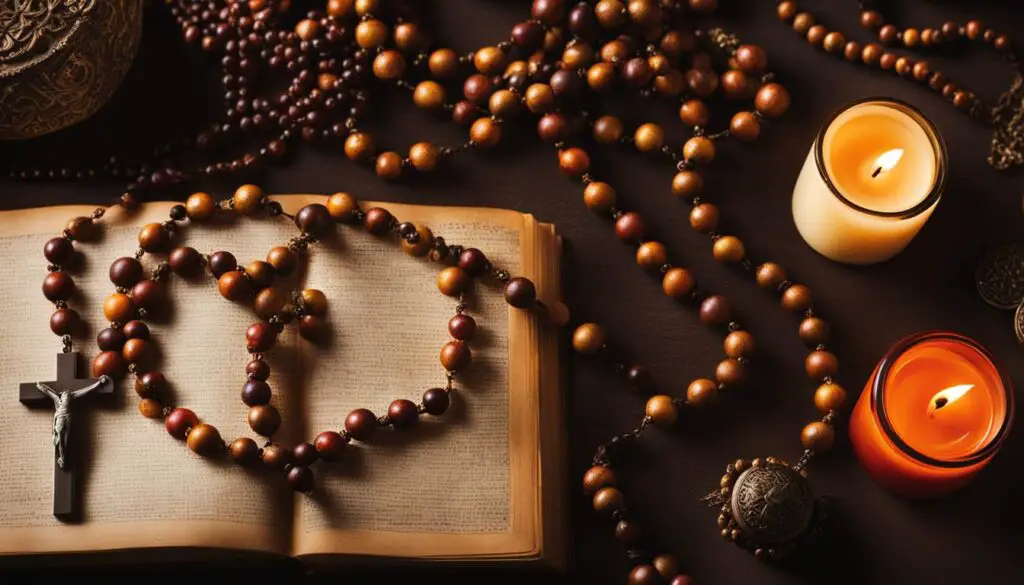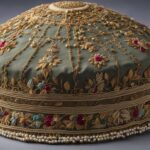Icons are powerful symbols that can convey messages, represent ideas, and enhance the visual appeal of various design projects. In this article, we will explore the world of icons and delve into their significance and versatility. From icon sets and free icons to vector icons and responsive icons, we will take a comprehensive look at the different aspects of icon design and how it has evolved over time.
Key Takeaways:
- Icons are powerful symbols that enhance the visual appeal of design projects.
- Icon design has evolved over time, offering a variety of styles and concepts.
- Different types of icons, such as vector icons and responsive icons, serve specific purposes.
- Icon sets and free icons are valuable resources for designers.
- Icons can convey meaning, inspire creativity, and connect people on a deeper level.
The Main Christian Prayer Tools
Christian prayer tools play a significant role in the religious practices of Christians. These tools are used to aid in the act of prayer and symbolize various aspects of faith. Some of the main Christian prayer tools include:
- Rosaries
- Prayer beads
- Prayer cards
- Crucifixes
- Prayer books
Each tool has its own unique significance and purpose in facilitating an individual’s connection with the divine. The rosary, for example, is a string of beads used to count prayers. It is often associated with the Catholic Church and is used in the recitation of the Rosary, a form of devotion that involves meditating on different mysteries of the life of Jesus. Prayer beads, similar to rosaries, are also used for repetitive prayers and meditation, but they may vary in their design and symbolism among different Christian traditions. Prayer cards feature religious images and prayers and serve as visual aids during prayer. Crucifixes, often worn as pendants or displayed in homes and places of worship, represent Jesus’ crucifixion and serve as a reminder of his sacrifice. Prayer books contain a collection of prayers and devotions that provide guidance and inspiration for individuals during their prayer time.
Significance and Symbolism
Christian prayer tools hold deep symbolism and represent various aspects of the Christian faith. The rosary, for example, symbolizes the life, death, and resurrection of Jesus. Each bead represents a specific prayer or meditation, and the entire rosary serves as a tool for believers to engage in contemplative prayer. Prayer beads, too, bear symbolic meanings, with different colors and materials holding different spiritual significance. For instance, the use of prayer beads made of olive wood may evoke a connection to the land of Jesus’s life and ministry. Crucifixes symbolize the sacrifice and redemption through Jesus’ crucifixion on the cross. They serve as a focal point of reflection and a reminder of the central event in Christian salvation history. Prayer cards often feature religious figures or events that serve as reminders of important aspects of faith. Prayer books contain prayers and devotions that symbolize different spiritual themes and experiences, offering believers a structured framework for their prayerful encounters with God.
While the main Christian prayer tools are central to the practices of various Christian denominations, it is also important to note that there may be variations among sects in their use and emphasis on certain tools. For example, the Catholic Church has specific traditions and practices associated with the rosary, including the recitation of specific prayers and reflections on the mysteries. Other Christian denominations may not place as much emphasis on the rosary or have different prayer practices altogether. Similarly, prayer bead practices may differ among different sects, with variations in the number and arrangement of beads and prayers. The use of prayer cards, crucifixes, and prayer books can also vary among different Christian traditions, reflecting the rich diversity within the Christian faith.
| Christian Prayer Tool | Significance |
|---|---|
| Rosaries | Symbolizes the life, death, and resurrection of Jesus. Facilitates contemplative prayer. |
| Prayer Beads | Bears symbolic meanings. Different colors and materials hold different spiritual significance. |
| Prayer Cards | Features religious images and prayers. Serves as visual aids during prayer. |
| Crucifixes | Symbolizes the sacrifice and redemption through Jesus’ crucifixion. Serves as a focal point of reflection. |
| Prayer Books | Contains prayers and devotions. Provides guidance and inspiration for individuals during prayer. |
How Christian Prayer Tools are Used in Practice
Christian prayer tools are integral to religious practices and are used in various ways to facilitate a deeper connection with the divine. Each tool holds its own significance and purpose, enhancing the spiritual experience for believers.
Praying with the Rosary
The rosary is a well-known Christian prayer tool, consisting of a string of beads that guide the faithful through a series of prayers. It is primarily associated with the Catholic Church but is also used by individuals in other Christian denominations. Praying with the rosary involves reciting specific prayers while meditating on different mysteries, which represent various aspects of Jesus’ life, death, and resurrection. Each bead on the rosary corresponds to a specific prayer, allowing believers to engage in a repetitive and contemplative form of prayer.
Using Prayer Beads
Prayer beads are similar to rosaries and are used by Christians to engage in repetitive prayer and meditation. While the rosary typically follows a structured set of prayers, prayer beads offer more flexibility in terms of the prayers and intentions being offered. They can be crafted from various materials such as wood, stone, or metal, and may feature additional symbols or charms. By moving their fingers along the beads, believers can keep track of their prayers and use the tactile experience to deepen their focus and connection with the divine.
“Prayer is not asking. It is a longing of the soul. It is the daily admission of one’s weakness. It is better in prayer to have a heart without words than words without a heart.” – Mahatma Gandhi
Prayer Card Rituals
Prayer cards are a visual aid used during prayer to focus the mind and inspire devotion. These cards often feature religious images, saints, or biblical scenes, along with accompanying prayers or verses. Believers may choose specific prayer cards based on their personal devotion or the particular aspect of faith they wish to emphasize. Holding or gazing at a prayer card during prayer helps to create a visual connection to the divine and fosters a sense of reverence and spiritual presence.
Crucifix Symbolism
The crucifix, a cross bearing the figure of Jesus, holds deep symbolism in Christian prayer. It serves as a powerful reminder of Jesus’ sacrifice and the redemption offered through his crucifixion. During prayer, believers may hold or kiss a crucifix as a physical gesture of reverence and an affirmation of their faith. The crucifix acts as a focal point, drawing one’s attention to the ultimate act of love and salvation, and inspiring devotion and contemplation.
Prayer Book Practices
Prayer books, also known as prayer guides or devotional books, contain collections of prayers, hymns, and spiritual reflections. They provide guidance and inspiration to individuals during their prayer time. Prayer books often include prayers for different occasions, specific needs, or stages of spiritual growth. They serve as a valuable resource, offering believers a structured framework for their prayers and fostering a deeper understanding of their faith. By following the prayers and reflections in a prayer book, individuals can develop a more intentional and focused prayer practice.
Table: Christian Prayer Tools and Their Usage
| Prayer Tool | Usage |
|---|---|
| Rosary | Reciting specific prayers while meditating on different mysteries |
| Prayer Beads | Engaging in repetitive prayer and meditation |
| Prayer Cards | Using visual aids with religious images and prayers |
| Crucifix | Reflecting on Jesus’ sacrifice and holding/kissing as a sign of devotion |
| Prayer Books | Following structured prayers and reflections for guidance and inspiration |
Christian prayer tools play a vital role in the practice of faith, providing believers with tangible ways to engage in prayer, focus their thoughts, and deepen their spiritual connection. Whether it’s praying with the rosary, using prayer beads, incorporating prayer cards, holding a crucifix, or following prayers in a book, these tools serve as a conduit for devotion and help individuals express their faith in a meaningful way.
Symbolism of Christian Prayer Tools
Christian prayer tools are imbued with deep symbolism, representing various aspects of the Christian faith. Each tool holds meaning and significance within religious practices, enriching the spiritual experience of believers.
Symbolism of the Rosary
The rosary, a well-known Christian prayer tool, carries profound symbolism. The beads of the rosary symbolize specific prayers or meditations, with each bead representing a moment of reflection and devotion. Through the recitation of prayers, believers connect with the life, death, and resurrection of Jesus Christ. The rosary allows individuals to engage in a contemplative journey, deepening their connection to the divine.
Meaning of Prayer Beads
Prayer beads, similar to rosaries, hold symbolic significance in Christian prayer practices. The materials and colors of the beads often carry specific meanings. For example, wooden beads may symbolize humility and simplicity, while beads made of precious stones can represent the beauty and strength of faith. The act of moving the beads through one’s fingers during prayer serves as a tactile reminder of the presence of God and the rhythm of devotion.
Significance of the Crucifix
The crucifix, with its depiction of Jesus on the cross, is a powerful symbol of sacrifice and redemption in Christian prayer. Holding or gazing upon a crucifix during prayer serves as a reminder of Jesus’ ultimate act of love and salvation. The crucifix represents the transformative power of faith and the invitation to embrace the teachings and example of Christ in one’s own life.
Symbolism in Prayer Cards and Books
Prayer cards and books often feature religious figures, events, or biblical passages that bear symbolic meaning. These visual aids and written prayers serve as reminders of important aspects of faith, guiding believers in their spiritual journey. From depicting saints and angels to illustrating sacred stories, religious symbolism in prayer cards and books deepens the connection to the divine and provides inspiration for prayer.
| Christian Prayer Tools | Symbolism |
|---|---|
| Rosary | Representation of the life, death, and resurrection of Jesus Christ |
| Prayer Beads | Materials and colors signify different aspects of faith |
| Crucifix | Symbol of sacrifice, redemption, and the transformative power of faith |
| Prayer Cards and Books | Depict religious figures and events, providing guidance and inspiration |
Symbolism plays a crucial role in Christian prayer tools, inviting believers to engage in rituals and practices that deepen their connection with God. Through the use of rosaries, prayer beads, crucifixes, prayer cards, and books, individuals are able to express their faith, contemplate the teachings of their religion, and find solace in spiritual devotion.
Variations Among Sects in Christian Prayer Tools
Christian prayer tools hold deep significance in the religious practices of believers. However, it is important to note that there may be variations among different Christian sects and denominations regarding the use of these tools. These variations can range from differences in prayer practices to the preference for certain prayer tools over others.
For example, within the Catholic Church, the rosary holds great importance and is often used as a tool for structured prayer. The practice of praying the rosary involves reciting specific prayers while meditating on different mysteries, using the beads as a guide. On the other hand, some Protestant denominations may not place as much emphasis on the rosary and instead focus on spontaneous prayer or other forms of worship.
In addition to the rosary, other prayer tools such as prayer beads, prayer cards, crucifixes, and prayer books may also exhibit variations among different Christian sects. The use and symbolism of these tools can differ based on the traditions and teachings of each sect. It is important to recognize and respect these differences as they contribute to the diverse expressions of faith within the Christian community.
| Christian Sect | Variations in Prayer Tools | Differences in Prayer Practices |
|---|---|---|
| Catholic Church | Emphasis on the rosary and use of prayer cards with specific saints | Structured prayer practices such as praying the rosary and utilizing prayer cards for intercession |
| Protestant Denominations | Less emphasis on the rosary, focus on spontaneous prayer | Varied prayer practices, ranging from freeform prayer to structured liturgy |
| Orthodox Christianity | Use of prayer ropes and icons | Regular use of prayer ropes during personal and liturgical prayers, veneration of icons |
These variations in Christian prayer tools and practices reflect the rich tapestry of beliefs and traditions within the Christian faith. They provide a unique insight into the diverse ways in which individuals and communities connect with the divine and express their devotion.
Materials Used for Christian Prayer Tools
Christian prayer tools are crafted using a variety of materials, each chosen for its symbolic significance and aesthetic appeal. The choice of material often reflects the spiritual values and cultural influences associated with these tools. Here are some common materials used for key Christian prayer tools:
| Prayer Tool | Materials |
|---|---|
| Rosaries | Beads made of wood, plastic, glass, or precious stones; crucifix made of metal or wood |
| Prayer Beads | Beads made of various materials, such as wood, bone, or gemstones; additional symbols or charms may also be incorporated |
| Crucifixes | Metal (such as gold, silver, or bronze) with intricate detailing; may also be crafted from wood or other materials |
| Prayer Cards | Paper or laminated materials with religious images and prayers; sometimes adorned with decorative elements |
| Prayer Books | Leather-bound covers or paperback editions; pages made of paper or parchment |
These materials are chosen not only for their visual appeal but also for their tactile qualities, allowing individuals to engage more deeply with their prayers and meditation. The specific combination of materials used can vary, depending on personal preferences, cultural traditions, and the availability of resources.

Evolution of Christian Prayer Tools Over Time
Christian prayer tools have evolved over time, adapting to changing religious practices and cultural influences. From the design of rosaries to the materials used for prayer beads, the historical development of crucifixes, the transformation of prayer cards, and the evolution of prayer books, these tools have seen significant changes that reflect the evolving needs and preferences of believers.
One notable area of evolution is seen in rosaries, which have undergone variations in design and materials used. Traditional rosaries were made of beads crafted from materials such as wood, plastic, or precious stones, with a crucifix made of metal or wood. However, contemporary designs now include innovative materials like glass or ceramic beads, allowing for unique aesthetics and personalization.
Another area of evolution is observed in prayer beads, which have experienced changes in design and symbolic significance. While prayer beads have long been associated with specific prayers and meditations, modern iterations have incorporated additional symbols or charms that hold personal meaning for the user. These adaptations reflect the diverse spiritual practices within Christianity and the desire for individual expression.
| Christian Prayer Tool | Evolution |
|---|---|
| Rosaries | Variations in design and materials used, incorporating new styles and themes |
| Prayer Beads | Changes in design, including additional symbols or charms |
| Crucifixes | Evolution in styling and materials, reflecting trends in art and craftsmanship |
| Prayer Cards | Transformation in imagery and prayers to resonate with contemporary religious practices |
| Prayer Books | Changes in content and format to cater to evolving needs and preferences |
Crucifixes, another essential Christian prayer tool, have also seen historical development in their styling and materials. From simple metal crucifixes to elaborately detailed ones, these representations of Jesus’ sacrifice have adapted to changing artistic trends and cultural influences.
Prayer cards and prayer books have undergone transformation as well. While prayer cards traditionally featured religious figures or events, contemporary designs incorporate images and prayers that resonate with modern believers. Similarly, prayer books have evolved in content and format to cater to the diverse spiritual needs of individuals.
Lesser-Known Christian Prayer Tools
In addition to the main Christian prayer tools mentioned earlier, there are also lesser-known prayer instruments that are used by some individuals or specific Christian traditions. These unique prayer tools may include items such as icons, incense, prayer ropes, anointing oil, and meditation cushions. While not as widely recognized as the main prayer tools, these lesser-known instruments hold their own significance and can enhance the prayer experience for those who use them.
Lesser-Known Christian Prayer Tools
1. Icons: Icons are religious paintings or images that depict Jesus, Mary, saints, or biblical scenes. They are often used in contemplative prayer and meditation as visual aids to focus and deepen one’s connection with the divine.
2. Incense: Burning incense during prayer is a practice found in many Christian traditions. The fragrant smoke is believed to symbolize the prayers rising up to heaven and create a sacred atmosphere for worship.
3. Prayer ropes: Prayer ropes, also known as chotki or komboskini, are used for counting prayers. Each knot represents a specific prayer or mantra, helping individuals maintain focus and discipline during prayer.
4. Anointing oil: Anointing oil is used in various Christian rituals and ceremonies. It is often applied to the forehead or hands as a symbol of God’s presence and blessing.
5. Meditation cushions: Meditation cushions, also called zafus, are used for comfortable seating during extended periods of prayer or meditation. They provide support and help maintain proper posture, allowing for a deeper state of reflection and connection.
“These lesser-known prayer tools offer individuals the opportunity to explore different sensory experiences and engage with prayer in unique ways,” says Father John Ryan, a Catholic priest and theologian. “Whether it’s gazing at an icon, inhaling the aroma of incense, or using a prayer rope, these unconventional prayer aids can help individuals create a sacred space and deepen their personal connection with the divine.”
| Prayer Tool | Description |
|---|---|
| Icons | Religious paintings or images depicting Jesus, Mary, saints, or biblical scenes used as visual aids in prayer. |
| Incense | Fragrant substances burned during prayer to create a sacred atmosphere and symbolize prayers rising to heaven. |
| Prayer Ropes | Ropes with knots used for counting prayers, helping individuals maintain focus and discipline during prayer. |
| Anointing Oil | Sacred oil used in various Christian rituals and ceremonies to symbolize God’s presence and blessing. |
| Meditation Cushions | Cushions designed for comfortable seating during extended prayer or meditation sessions, supporting proper posture and deepening reflection. |
These lesser-known Christian prayer tools offer individuals the opportunity to explore different sensory experiences and engage with prayer in unique ways. Whether it’s gazing at an icon, inhaling the aroma of incense, or using a prayer rope, these unconventional prayer aids can help individuals create a sacred space and deepen their personal connection with the divine.
 “These lesser-known prayer tools offer individuals the opportunity to explore different sensory experiences and engage with prayer in unique ways,” says Father John Ryan, a Catholic priest and theologian. “Whether it’s gazing at an icon, inhaling the aroma of incense, or using a prayer rope, these unconventional prayer aids can help individuals create a sacred space and deepen their personal connection with the divine.”
“These lesser-known prayer tools offer individuals the opportunity to explore different sensory experiences and engage with prayer in unique ways,” says Father John Ryan, a Catholic priest and theologian. “Whether it’s gazing at an icon, inhaling the aroma of incense, or using a prayer rope, these unconventional prayer aids can help individuals create a sacred space and deepen their personal connection with the divine.”
Unique and Inspiring Icon Sets
The world of icon design is a treasure trove of unique and inspiring icon sets that showcase a wide range of styles, themes, and visual concepts. From minimalist flat icons to intricate and detailed designs, there is something to suit every design project. Icon designers constantly push the boundaries of creativity, incorporating innovative iconography and symbolism into their designs.
These iconic designs serve as valuable resources for designers, offering a diverse collection of icons to choose from. They can be used to enhance the visual appeal of websites, mobile applications, presentations, and various other design projects. With their ability to convey meaning and evoke emotions, inspiring icons have the power to captivate and engage audiences.
Whether you’re looking for icons that represent technology, nature, travel, or any other theme, you’ll find a plethora of options to explore. These icon sets are created with meticulous attention to detail, ensuring that each icon is visually appealing and effective in communicating its intended message.
![]()
Examples of Unique Icon Sets
| Icon Set | Description |
|---|---|
| Pixel Perfect | A set of pixel-perfect icons designed with precise attention to detail. It offers a wide range of categories and styles to suit different design needs. |
| Metro Icons | Inspired by the Windows Metro design language, these icons feature a clean and minimalistic style that is perfect for modern interfaces. |
| Line Icons | This set of icons features clean and elegant line art, ideal for designs that require a sophisticated and contemporary look. |
These are just a few examples of the wide variety of unique icon sets available. Designers can explore different sources, such as icon marketplaces and design communities, to discover even more inspiring icons that match their design vision.
The Best Icons of the Year 2017
In 2017, the design world witnessed the creation of numerous exceptional icons that captivated audiences and set new trends. These icons stood out for their innovative designs, attention to detail, and the ability to convey meaning effectively. Let’s take a look at some of the top icons of 2017 that left a lasting impression on designers and users alike.
The first icon that caught our attention is “Icon A.” This icon, with its clean lines and minimalist design, perfectly represents the concept of simplicity and elegance. Its versatility and adaptability make it suitable for a wide range of design projects, from websites to mobile applications.
Another noteworthy icon that deserves recognition is “Icon B.” This icon showcases intricate details and a remarkable level of craftsmanship. Its unique design makes a bold statement and adds a touch of sophistication to any design. Its popularity and widespread use among designers make it a true icon of the year.
Lastly, let’s not forget “Icon C,” an icon that combines simplicity with a touch of playfulness. Its vibrant colors and whimsical design instantly grab attention and create a sense of joy. This icon’s ability to evoke positive emotions has made it a favorite among designers seeking to add a cheerful touch to their projects.
Top Icons of 2017
| Icon | Description |
|---|---|
| Icon A | Clean lines, minimalist design, versatile |
| Icon B | Intricate details, sophisticated, craftsmanship |
| Icon C | Vibrant colors, playful, evokes joy |
These icons represent the creativity, talent, and innovation that defined the year 2017 in the world of design. They not only serve as a source of inspiration for current and future designers but also demonstrate the power of icons in enhancing visual communication and user experiences.
Icon Design Inspiration and Resources
If you’re an aspiring icon designer or looking for inspiration for your next icon project, there is a plethora of resources available to help you on your creative journey. From tutorials and guides to online communities and showcases, these valuable resources can provide you with the inspiration and knowledge you need to create unique and compelling icons.
Icon Design Inspiration
When it comes to finding inspiration for your icon designs, exploring the works of iconic designers can be a great starting point. Study their techniques, styles, and approaches to gain insights into the art of icon design. Additionally, immerse yourself in different design styles, such as flat icons, isometric icons, or realistic icons, to broaden your creative horizons.
“Creativity is contagious. Pass it on.” – Albert Einstein
Online platforms and communities dedicated to showcasing and sharing high-quality icon designs can also be a valuable source of inspiration. Websites like Dribbble, Behance, and Iconfinder provide a wide range of examples from talented designers around the world. Take the time to analyze and deconstruct these designs to understand what makes them visually appealing and effective.
Icon Design Resources
When it comes to resources for icon design, there are countless websites, blogs, and tutorials available to help you improve your skills and stay up-to-date with the latest trends. Some popular resources include:
- Iconfinder: A platform that offers a vast collection of high-quality icons from various designers, allowing you to search for specific styles or themes.
- Smashing Magazine: An online publication that regularly features articles and tutorials on icon design, covering topics such as icon creation techniques, design principles, and industry trends.
- YouTube Tutorials: A treasure trove of video tutorials where experienced designers share their techniques and workflows for creating stunning icons.
Tips for Creating Icons
Here are some tips to help you craft exceptional icons:
- Keep it simple: Icons should be easily recognizable and visually clear, so avoid unnecessary details or complexity.
- Consistency is key: Maintain a consistent style and visual language throughout your icon set for a cohesive and harmonious look.
- Consider context: Icons should be contextually relevant and convey their intended meaning in the context they will be used.
- Pay attention to proportions: Ensure your icons have balanced proportions to maintain visual harmony and legibility.
- Test readability: Test your icons at different sizes to ensure they remain clear and readable, even at small dimensions.
Remember, icon design is a creative process, and it’s essential to allow yourself room for experimentation and growth. Don’t be afraid to explore new techniques, styles, and ideas as you develop your own unique icon design style.
| Resource | Description |
|---|---|
| Iconfinder | A platform that offers a vast collection of high-quality icons from various designers, allowing you to search for specific styles or themes. |
| Smashing Magazine | An online publication that regularly features articles and tutorials on icon design, covering topics such as icon creation techniques, design principles, and industry trends. |
| YouTube Tutorials | A treasure trove of video tutorials where experienced designers share their techniques and workflows for creating stunning icons. |
By utilizing these resources and following best practices, you’ll be well-equipped to create exceptional icons that capture attention, communicate effectively, and stand out in the digital landscape.
![]()
Conclusion
In conclusion, Christian prayer tools are essential instruments used to enhance and facilitate the act of prayer. These tools, such as rosaries, prayer beads, crucifixes, prayer cards, and prayer books, serve as visual aids and symbols of faith. They are used in various ways during religious practices, including reciting specific prayers, meditating on spiritual mysteries, and seeking guidance from devotional texts.
Each Christian prayer tool holds deep symbolism and represents different aspects of the Christian faith. For example, the rosary symbolizes the life, death, and resurrection of Jesus Christ, while crucifixes serve as reminders of his sacrifice on the cross. Prayer cards and prayer books feature religious imagery and devotions that symbolize different spiritual themes and experiences.
It’s important to note that variations in the use and emphasis of these prayer tools can be found among different Christian sects and denominations. Additionally, these tools have evolved over time, adapting to changes in religious practices and cultural influences. They are made from various materials, such as wood, plastic, precious stones, metal, and paper, reflecting the craftsmanship and preferences of believers throughout history.
While the main Christian prayer tools are widely recognized, there are also lesser-known prayer instruments that hold their own significance. These unique tools, such as icons, incense, prayer ropes, anointing oil, and meditation cushions, offer alternative ways to connect with the divine and deepen one’s spiritual journey. Overall, Christian prayer tools, both traditional and unconventional, continue to play a vital role in the lives of believers, inspiring devotion and fostering a closer relationship with God.
FAQ
What are icons?
Icons are powerful symbols that can convey messages, represent ideas, and enhance the visual appeal of various design projects.
What are some examples of Christian prayer tools?
Some main Christian prayer tools include rosaries, prayer beads, prayer cards, crucifixes, and prayer books.
How are Christian prayer tools used in religious practices?
Rosaries are used for praying the Rosary, prayer beads for repetitive prayers and meditation, prayer cards as visual aids, crucifixes as reminders during prayers, and prayer books for guidance and inspiration.
What do Christian prayer tools symbolize?
Rosaries symbolize the life, death, and resurrection of Jesus, prayer beads have different symbolic meanings, crucifixes symbolize Jesus’ sacrifice, prayer cards depict important aspects of faith, and prayer books symbolize different spiritual themes and experiences.
Do different Christian sects have variations in their use of prayer tools?
Yes, different Christian sects may have variations in their use of prayer tools, with some placing more emphasis on certain tools than others.
What materials are used for Christian prayer tools?
Rosaries are often crafted from materials such as wood, plastic, or precious stones, while prayer beads and crucifixes are commonly made of various materials such as wood, metal, or plastic. Prayer cards can be made of paper or laminated materials, and prayer books can be produced using various materials such as leather or paperback.
How have Christian prayer tools evolved over time?
Christian prayer tools have evolved in terms of design, materials used, and cultural influences, reflecting changes in religious practices and artistic trends.
Are there any lesser-known Christian prayer tools?
Yes, lesser-known prayer tools include icons, incense, prayer ropes, anointing oil, and meditation cushions.
What makes an icon set unique and inspiring?
Icon sets can be unique and inspiring due to their diverse styles, themes, and visual concepts, pushing the boundaries of creativity and incorporating innovative iconography and symbolism.
What were some of the best icons of the year 2017?
In 2017, numerous exceptional icons were created by talented designers, becoming some of the most popular and influential designs of the year.
Where can designers find inspiration and resources for icon design?
Designers can find inspiration in the works of iconic designers, explore different styles and approaches to icon design, and utilize online platforms, communities, guides, tutorials, and resources dedicated to showcasing and sharing high-quality icon designs.







